It looks like you're using an Ad Blocker.
Please white-list or disable AboveTopSecret.com in your ad-blocking tool.
Thank you.
Some features of ATS will be disabled while you continue to use an ad-blocker.
share:
Consider two aspects of truss failure theory:
Before we go any further, note how the second point above is impossible to prove. It is like your classic conspiracy theory: its strength lies in the fact that it cannot be proven true or false. If the buckling was too rapid to be seen or filmed, how do we know it ever occurred? But it gets worse.
The buckling that existed pre-collapse was of a small number of perimeter columns, spread across different floors. This small number of buckled columns was obviously not enough to initiate a global collapse. Considering the great redundancy of the Towers, and all modern skyscrapers, the buckled columns observed pre-collapsed would have posed no real threat to global stability.
The buckling was also slow to come about, and did not result in any immediate failures of neighboring trusses.
(Note that in the above image, all the dangling pieces of metal are aluminum coverings, not the actual perimeter columns, which were steel.)
Yet how do we get from a few buckled columns, to global collapse?
The answer is apparently that the remaining failures necessary to initiate collapse were so fast, we weren't able to see them!
Even though the pre-collapse buckling came about slowly, and did not result in rapid buckling of neighboring perimeter columns (by similar truss failures, allegedly), we are to believe that the alleged buckling that occurred just prior to the collapses was so fast that we weren't able to see it? How can you have truss failures that cause buckling very slowly, and also truss failures that are too quick to be photographed or videotaped, all on the very same floors of the WTC Towers? It would have to be a very large number of failures, too, to manage to cause a whole floor to collapse whereas there was previously only minor buckling apparent.
If buckling failures cause lightning-fast chain reactions, then they should have from the beginning. If they do not cause lightning-fast chain reactions, then they would NOT have, from the beginning. And in the beginning, they did NOT result in lightning-fast chain reactions, invisible to the naked eye. Same buildings, same floors, same structural elements. Everything should have been the same.
I submit that the reason we did not see any additional buckling before the collapses began, is not because it was a super-fast, invisible chain reaction, but because buckling was not the cause of the collapses.
Photos of buckling after the collapses were already underway also do nothing to reconcile this, as it would be natural for buckling to occur after the structure had already began failing by some other mechanism.
[edit on 31-7-2006 by bsbray11]
- Buckling existed well before collapse initiations, and came about slowly and steadily.
- The alleged failings of trusses just before collapse initiations were lightning-fast across whole floors, too quick for buckling to be filmed or photographed, enabling totally symmetrical collapses.
Before we go any further, note how the second point above is impossible to prove. It is like your classic conspiracy theory: its strength lies in the fact that it cannot be proven true or false. If the buckling was too rapid to be seen or filmed, how do we know it ever occurred? But it gets worse.
The buckling that existed pre-collapse was of a small number of perimeter columns, spread across different floors. This small number of buckled columns was obviously not enough to initiate a global collapse. Considering the great redundancy of the Towers, and all modern skyscrapers, the buckled columns observed pre-collapsed would have posed no real threat to global stability.
The buckling was also slow to come about, and did not result in any immediate failures of neighboring trusses.
(Note that in the above image, all the dangling pieces of metal are aluminum coverings, not the actual perimeter columns, which were steel.)
Yet how do we get from a few buckled columns, to global collapse?
The answer is apparently that the remaining failures necessary to initiate collapse were so fast, we weren't able to see them!
Originally posted by HowardRoark
Unless you had a high speed camera trained on the building at that point, you would not be able to see the progression of the failure. It would look instantaneous.
Even though the pre-collapse buckling came about slowly, and did not result in rapid buckling of neighboring perimeter columns (by similar truss failures, allegedly), we are to believe that the alleged buckling that occurred just prior to the collapses was so fast that we weren't able to see it? How can you have truss failures that cause buckling very slowly, and also truss failures that are too quick to be photographed or videotaped, all on the very same floors of the WTC Towers? It would have to be a very large number of failures, too, to manage to cause a whole floor to collapse whereas there was previously only minor buckling apparent.
If buckling failures cause lightning-fast chain reactions, then they should have from the beginning. If they do not cause lightning-fast chain reactions, then they would NOT have, from the beginning. And in the beginning, they did NOT result in lightning-fast chain reactions, invisible to the naked eye. Same buildings, same floors, same structural elements. Everything should have been the same.
I submit that the reason we did not see any additional buckling before the collapses began, is not because it was a super-fast, invisible chain reaction, but because buckling was not the cause of the collapses.
Photos of buckling after the collapses were already underway also do nothing to reconcile this, as it would be natural for buckling to occur after the structure had already began failing by some other mechanism.
[edit on 31-7-2006 by bsbray11]
So whats your theory?
Invisible and silent explosives that leave no patterns or desidue?
A new style of top/down demo?
Are you saying that the structure got stronger after the obvious buckling progressed?
I'm just asking...what IS it you're trying to say?
Invisible and silent explosives that leave no patterns or desidue?
A new style of top/down demo?
Are you saying that the structure got stronger after the obvious buckling progressed?
I'm just asking...what IS it you're trying to say?
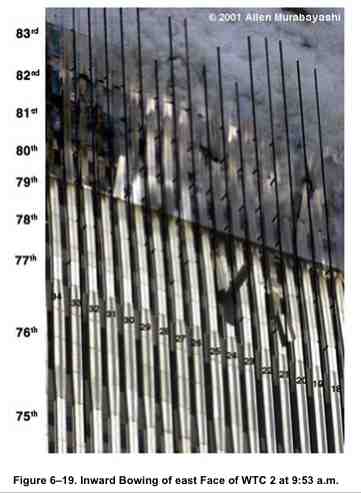
The buckling of the east face of WTC-2
The lines indicate the extent of the inward movement of the exterior columns from vertical.
WTC 1, shortly before the collapse. In this picture, the numbers indicate the estimated inward movement of the exterior columns in inches.
Originally posted by Vushta
So whats your theory?
Invisible and silent explosives that leave no patterns or desidue?
A new style of top/down demo?
Are you saying that the structure got stronger after the obvious buckling progressed?
I'm just asking...what IS it you're trying to say?
Speaking for myself, and NOT bsbray11:
1. Not silent, just camoflauged.
2. Pattern was PERFECT. Watch the video.
3. Top down demo does not seem to hard... just reverse the order maybe + basement support removal (explosions firefigters reported)
4. No one LOOKED FOR RESIDUE (NIST, FEMA, 9/11 Comission). People are currently in the process of doing so (ST911) ub the evidence was shipped off... Long process.
5. Buckling did not progress.
I am trying to say the buildings were taken down via CD.. a special CD with a specific set of requirements that were met.
Now, back on this great topic. Sorry BSBray.
Originally posted by Slap Nuts
I am trying to say the buildings were taken down via CD.. a special CD with a specific set of requirements that were met.
In a way never done before. In a way that had to be 100% secret and foolproof, but yet happen with witnesses both onsite and with cameras. In a way that was in full view of the media. In a way that had never been tried or tested.
In a way that was unsure if it would work. It had to be timed with hijack attacks and many other events in a completely coordinated way that also was completely foolproof AND that would never be discovered.
It's amazing that a govenment and a military that are so inept, yet could handle this so well. I mean imagine it crossed the military, the CIA, police, fire, and maybe a few other groups (demolition experts for sure) and still managed to get done (that's amazing) and nobody has talked.
It's the greatest hoodwink ever!
or...maybe it was an accident. Naw!
dang... whole thing got "gateway time outted. will repost later.
[edit on 31-7-2006 by Slap Nuts]
[edit on 31-7-2006 by Slap Nuts]
A few questions answered:
What caused the buckle?
Basically, the buckle was caused by the loss of stability to the columns. The stability that was imparted to the columns by the floors.
If the floor trusses failed due to the effects of the impacts and the fires, then they would not longer provide the necessary lateral bracing to the exterior columns.
Why would the floor trusses fail?
All floor trusses will fail if exposed to a sufficient amount of heat for a sufficient amount of time. The WTC floor trusses were designed to be able to withstand a standard fire scenario for at least 2 hours. This was based on the application of monokote fireproofing to the trusses.
Unfortunately, there is evidence that the thickness of the applied fireproofing did not quite meet this criterion. Furthermore, after 30 years, the friable fireproofing was known to be in poor condition throughout the building.
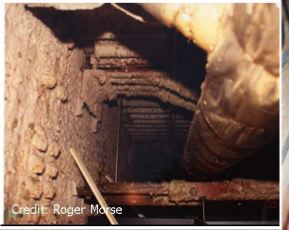
This is a picture of the actual WTC truss exterior wall connections. Note that you can clearly see the truss primer paint through the fireproofing, and that in some cases it is totally non-existent. If it were sprayed on to the proper thickness you would not be able to count the individual bolts on the spandrel.
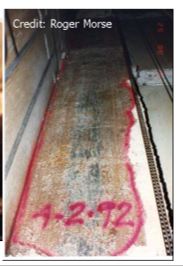
This is a picture of the fireproofing on a core column in one of the elevator shafts. Poor quality control during the installation caused the fireproofing to be applied to rusty steel. The scale prevented the fireproofing from adhering properly to the column.
Finally, the simple fact is that the fireproofing would have been severely damaged and knocked off the trusses by the forces of the impacts and fuel explosions. Thus, the 2-hour fire rating of the floors was not applicable to this situation.
What would have happened to the trusses then?
According to this paper, a truss of the type used in the WTC structures would have started to fail after about 20 minutes exposure to a standard fire.
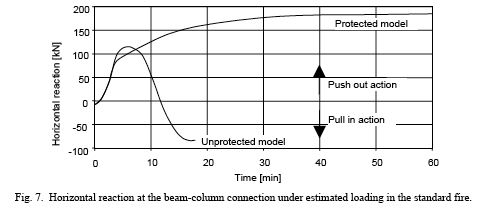
After an initial expansion, the truss diagonals will buckle and the truss will start to sag, pulling inward.
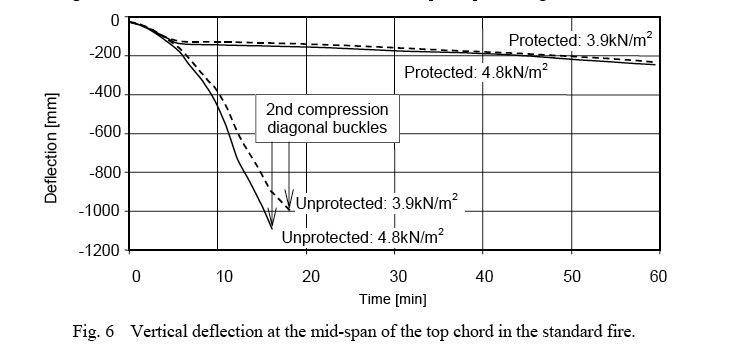
The downward sagging of the truss would then cause the exterior columns to pull inward.

Thus the cause of the buckle becomes apparent.
What caused the buckle?
Basically, the buckle was caused by the loss of stability to the columns. The stability that was imparted to the columns by the floors.
If the floor trusses failed due to the effects of the impacts and the fires, then they would not longer provide the necessary lateral bracing to the exterior columns.
Why would the floor trusses fail?
All floor trusses will fail if exposed to a sufficient amount of heat for a sufficient amount of time. The WTC floor trusses were designed to be able to withstand a standard fire scenario for at least 2 hours. This was based on the application of monokote fireproofing to the trusses.
Unfortunately, there is evidence that the thickness of the applied fireproofing did not quite meet this criterion. Furthermore, after 30 years, the friable fireproofing was known to be in poor condition throughout the building.

This is a picture of the actual WTC truss exterior wall connections. Note that you can clearly see the truss primer paint through the fireproofing, and that in some cases it is totally non-existent. If it were sprayed on to the proper thickness you would not be able to count the individual bolts on the spandrel.

This is a picture of the fireproofing on a core column in one of the elevator shafts. Poor quality control during the installation caused the fireproofing to be applied to rusty steel. The scale prevented the fireproofing from adhering properly to the column.
Finally, the simple fact is that the fireproofing would have been severely damaged and knocked off the trusses by the forces of the impacts and fuel explosions. Thus, the 2-hour fire rating of the floors was not applicable to this situation.
What would have happened to the trusses then?
According to this paper, a truss of the type used in the WTC structures would have started to fail after about 20 minutes exposure to a standard fire.

After an initial expansion, the truss diagonals will buckle and the truss will start to sag, pulling inward.

The downward sagging of the truss would then cause the exterior columns to pull inward.

Thus the cause of the buckle becomes apparent.
Originally posted by bsbray11
The buckling that existed pre-collapse was of a small number of perimeter columns, spread across different floors. This small number of buckled columns was obviously not enough to initiate a global collapse. Considering the great redundancy of the Towers, and all modern skyscrapers, the buckled columns observed pre-collapsed would have posed no real threat to global stability.
This is based on what?
It is clear that the buckles developed well after the impacts.
The buckle is not visible here

or here
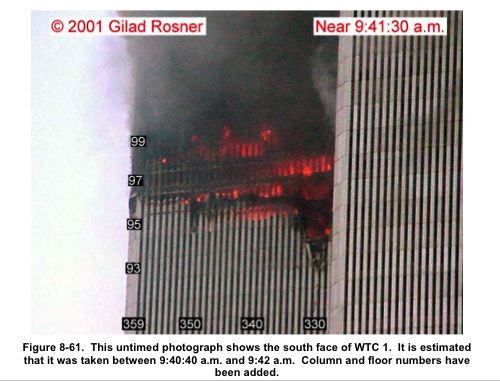
But it is clear here.
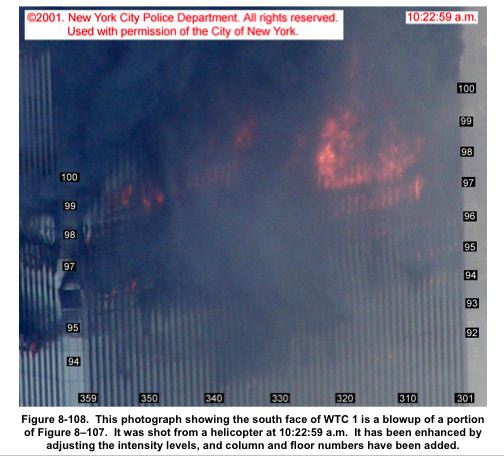
This indicates that serious changes were occurring to the structural stability of the building.
Furthermore, that is not a “small number of perimeter columns” but rather the entire south face was structurally compromised.
Originally posted by Vushta
Are you saying that the structure got stronger after the obvious buckling progressed?
I'm just asking...what IS it you're trying to say?
I think it's pretty clear what I was trying to say in the first post. What I think happened, as you would say, is a "deflection". Changing the subject.
HowardRoark,
All of your posts so far on this thread amount to rehashing the same theory this thread exposes an inconsistency with, and arm waving.
The problem is that columns would have been buckling very slowly throughout the fires, but then all of a sudden there was a super-fact wave of failures that, according to you, was too fast to be picked up by video.
You can't have two contradictory structural behaviors in the same system, allegedly resulting from the same basic failures.
Howardroark,
If the south face was buckling, how do you account for the lack of entropy in the system that allowe the straight down collapse instead ofa toppling motion?
If the south face was buckling, how do you account for the lack of entropy in the system that allowe the straight down collapse instead ofa toppling motion?
Originally posted by Slap Nuts
Howardroark,
If the south face was buckling, how do you account for the lack of entropy in the system that allowe the straight down collapse instead ofa toppling motion?
Entropy is a thermodynamic concept that is not applicable to this situation.
Gee, Howard. I can't understand why you keep ignoring this:
You seem to rather spam pictures and address concerns that I haven't even voiced, rather than address the above.
Originally posted by bsbray11
The problem is that columns would have been buckling very slowly throughout the fires, but then all of a sudden there was a super-fact wave of failures that, according to you, was too fast to be picked up by video.
You can't have two contradictory structural behaviors in the same system, allegedly resulting from the same basic failures.
You seem to rather spam pictures and address concerns that I haven't even voiced, rather than address the above.
I think it's pretty clear what I was trying to say in the first post. What I think happened, as you would say, is a "deflection". Changing the subject.
Well actually no. It was a serious question.
One of the consistant things I see in CTs is the tendency to keep the theory very vague to allow for skipping around and dodging.
So I'm still wondering what you are stating. Were the towers blown by explosives? where the supports cut with thermite? were there bombs on the planes? was it pre placed thermite and bombs on the plane? was it preplaced explosives and preplaced thermite and the planes were just a cover? Were the floors taken out ahead of the collapse by blowing the connectors? ..or was the core just cut away with thermite?..so the question remains..what are you trying to say?
Vushta, please start another thread if you want to discuss those things. It is totally off topic from my original post.
Originally posted by HowardRoark
Originally posted by Slap Nuts
Howardroark,
If the south face was buckling, how do you account for the lack of entropy in the system that allowe the straight down collapse instead ofa toppling motion?
Entropy is a thermodynamic concept that is not applicable to this situation.
There is more than one definition and you know this... the tendency of ANY system to advance towards chaos.
Originally posted by bsbray11
Vushta, please start another thread if you want to discuss those things. It is totally off topic from my original post.
On the contrary, all the questions he posed are totally in line with the vague claims you make in the original post.
Why are you being so vague about your point?
Your topic claims that the truss failure theory is critically flawed. What we should replace it with is definitely on topic.
It is ludicrous to say things like,
because buckling was not the cause of the collapses.
And then say it's off topic to ask for you to elaborate on such a bold statement.
What was the cause of collapse, if the entire south face buckling was "not enough damage"?
HR has clearly shown how the buckling came about after the impact of the aircraft, and as such was directly caused by the fires, aided by the weakening of the structure caused by the impact.
Why is the buckling of an entire side of the building not enough for you? Why are you even qualified to make this judgement?
I am not qualified to do so either, but all the experts agree with what I think happened, while not one expert agrees with your interpretation.
LB, you are, yet again, not understanding the argument. Why is this so frequent for you? Reread it. I'm not simply claiming there wasn't enough
buckling.
I'm comparing two contradictory behaviors of the structural aspects related to the buckling, during the length of the fires, and in the very short amount of time before the collapses began, in which it is alleged that massive amounts of buckling failures spontaneously took place by propogating themselves.
This is also not vague, if you would only understand what I am pointing out, and yes, it is off topic to derail the thread into other issues. When Vushta makes his other thread, feel free to chime in there, but at least try to understand the problem pointed out here and try to clarify yourselves or something, rather than just avoid the problem altogether by attempting to change subjects. That's all HowardRoark's been doing here as well.
I'm comparing two contradictory behaviors of the structural aspects related to the buckling, during the length of the fires, and in the very short amount of time before the collapses began, in which it is alleged that massive amounts of buckling failures spontaneously took place by propogating themselves.
This is also not vague, if you would only understand what I am pointing out, and yes, it is off topic to derail the thread into other issues. When Vushta makes his other thread, feel free to chime in there, but at least try to understand the problem pointed out here and try to clarify yourselves or something, rather than just avoid the problem altogether by attempting to change subjects. That's all HowardRoark's been doing here as well.
How are the two behaviors contradictory?
They are just represent a change from a stable to an unstable condition.
www.mech.uwa.edu.au...
I found the following quite interesting:
You could almost visualize the exterior framed tube structure of the WTC towers behaving in a similar manner; the only difference is that it is a flat walled tube and not a cylindrical shell.
Also found this:
source
This suggests that once the buckle formed, the movement of the exterior walls caused additional failure to the floor slabs.
They are just represent a change from a stable to an unstable condition.
Buckling proceeds in manner which may be either :
stable
in which case displacements increase in a controlled fashion as loads are increased, ie. the structure's ability to sustain loads is maintained, or
unstable -
in which case deformations increase instantaneously, the load carrying capacity nose- dives and the structure collapses catastrophically.
. . . .
If buckling deflections become too large then the structure fails - this is a geometric consideration, completely divorced from any material strength consideration. If a component or part thereof is prone to buckling then its design must satisfy both strength and buckling safety constraints - that is why we now examine the subject of buckling.
www.mech.uwa.edu.au...
I found the following quite interesting:
The behaviour of a compressed shell after buckling is quite different to that of a plate; in this case an unstable ( negative ) stiffness is accompanied by a sudden reduction of load capacity.
Since the displacements are uncontrolled in most practical systems, shells behave in a snap- buckling mode - ie. as an increasing load reaches the bifurcation point, the cylinder must undergo an instantaneous increase in deflection ( "snap" ) to the point 1 in order to accomodate the increasing load. A subsequent decrease in load is accomodated by a corresponding decrease in buckling deflection until the point 2 is reached whereupon the structure again snaps instantaneously - this time back to the point 3 on the primary path.
You could almost visualize the exterior framed tube structure of the WTC towers behaving in a similar manner; the only difference is that it is a flat walled tube and not a cylindrical shell.
Also found this:
The paper further investigates the results of this analysis to obtain the details of the collapse mechanism found. An interesting series of events leading progressively to overall collapse are discovered and described in detail. The main reason for the failure is found to be the low membrane capacity in compression of the composite steel truss and concrete deck slab floor system.
source
This suggests that once the buckle formed, the movement of the exterior walls caused additional failure to the floor slabs.
Originally posted by HowardRoark
How are the two behaviors contradictory?
They are just represent a change from a stable to an unstable condition.
By what mechanism? What allows a clear minority of columns to so suddenly become so unstable that a whole floor fails instantaneously, too quick to be filmed?
Instantaneous buckling does not equate to instantaneous propogation of buckling, as you suggest, let alone propogation too quickly to be filmed. And buckling and buckling from truss failures imply two different things in regards to your sources, which you also fail to consider.
At least you're trying now! Baby steps, HowardRoark. I'm sure you can find a way to make it through this.
[edit on 1-8-2006 by bsbray11]
Originally posted by bsbray11
Originally posted by HowardRoark
How are the two behaviors contradictory?
They are just represent a change from a stable to an unstable condition.
By what mechanism? What allows a clear minority of columns to so suddenly become so unstable that a whole floor fails instantaneously, too quick to be filmed?
Instantaneous buckling does not equate to instantaneous propogation of buckling, as you suggest, let alone propogation too quickly to be filmed. And buckling and buckling from truss failures imply two different things in regards to your sources, which you also fail to consider.
Okay, actually it would. This issue here is very much like talking about, say, a failed balcony. Let's say the balcony was rated to 10,000 lbs, and then one day a bunch of people get on it and it fails. And low and behold its found out there were 10,001 lbs of people on it. It wasn't the first 10,000 lbs that failed the balcony, it was the final 1 lb.
The same is true when you get to the point you are overloading an system of elements that SHOULD BE very similar in failure point. With some deviation from the average strength (both plus and minus), you'll start having the weaker members gradually give way and with each failure the load increases on the stronger ones. And eventually, you'll get to the point that you have crossed the "average strength line" - and at that point it's "Katy Bar the Door".
So, NO, they are not contradictory phenomena, they are complimentary phenomena. If there was evidence of sudden buckling WITHOUT gradual buckling prior to it - I would have probably already made up my mind some one detonated something.
[edit on 8-1-2006 by Valhall]
new topics
-
Paradox of Progress
Ancient & Lost Civilizations: 4 hours ago -
Joe Biden gives the USA's Highest Civilian Honor Award to Hillary Clinton and George Soros.
US Political Madness: 7 hours ago -
Winter Storm
Fragile Earth: 7 hours ago -
Biden Face Planted Somewhere
Politicians & People: 9 hours ago -
A great artist and storyteller, for kids of all ages
General Entertainment: 10 hours ago
top topics
-
Joe Biden gives the USA's Highest Civilian Honor Award to Hillary Clinton and George Soros.
US Political Madness: 7 hours ago, 13 flags -
What Is 'Quad Demic'? Mask Mandate Returns In These US States
Diseases and Pandemics: 14 hours ago, 11 flags -
Volcano Watch 2025
Fragile Earth: 16 hours ago, 8 flags -
The Future of fashion .
Social Issues and Civil Unrest: 14 hours ago, 8 flags -
Winter Storm
Fragile Earth: 7 hours ago, 7 flags -
Bin Cyber Junk…
Short Stories: 15 hours ago, 6 flags -
Biden Face Planted Somewhere
Politicians & People: 9 hours ago, 5 flags -
A great artist and storyteller, for kids of all ages
General Entertainment: 10 hours ago, 5 flags -
Paradox of Progress
Ancient & Lost Civilizations: 4 hours ago, 5 flags -
The Undertones - Teenage Kicks
Music: 16 hours ago, 3 flags
active topics
-
Post A Funny (T&C Friendly) Pic Part IV: The LOL awakens!
General Chit Chat • 7988 • : KrustyKrab -
Winter Storm
Fragile Earth • 18 • : RickyD -
What Is 'Quad Demic'? Mask Mandate Returns In These US States
Diseases and Pandemics • 29 • : TheRickestRick -
Paradox of Progress
Ancient & Lost Civilizations • 3 • : BingoMcGoof -
Here we again... CHINA having mass outbreak of something
Diseases and Pandemics • 24 • : NoCorruptionAllowed -
A great artist and storyteller, for kids of all ages
General Entertainment • 1 • : angelchemuel -
-@TH3WH17ERABB17- -Q- ---TIME TO SHOW THE WORLD--- -Part- --44--
Dissecting Disinformation • 3931 • : RelSciHistItSufi -
Joe Biden gives the USA's Highest Civilian Honor Award to Hillary Clinton and George Soros.
US Political Madness • 29 • : caterpillage -
NJ Drones tied to Tesla explosion at Trump Las vegas
General Conspiracies • 45 • : glen200376 -
New Jersey-Teachers Can Now Be Certified Without Passing Basic Reading Writing Math Testing
Education and Media • 14 • : boatguy12

